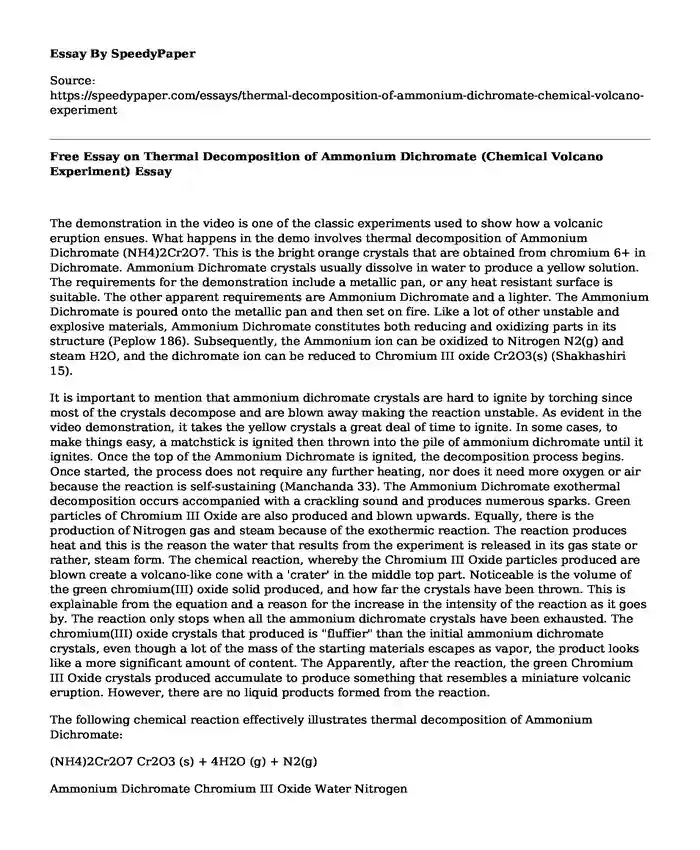The demonstration in the video is one of the classic experiments used to show how a volcanic eruption ensues. What happens in the demo involves thermal decomposition of Ammonium Dichromate (NH4)2Cr2O7. This is the bright orange crystals that are obtained from chromium 6+ in Dichromate. Ammonium Dichromate crystals usually dissolve in water to produce a yellow solution. The requirements for the demonstration include a metallic pan, or any heat resistant surface is suitable. The other apparent requirements are Ammonium Dichromate and a lighter. The Ammonium Dichromate is poured onto the metallic pan and then set on fire. Like a lot of other unstable and explosive materials, Ammonium Dichromate constitutes both reducing and oxidizing parts in its structure (Peplow 186). Subsequently, the Ammonium ion can be oxidized to Nitrogen N2(g) and steam H2O, and the dichromate ion can be reduced to Chromium III oxide Cr2O3(s) (Shakhashiri 15).
It is important to mention that ammonium dichromate crystals are hard to ignite by torching since most of the crystals decompose and are blown away making the reaction unstable. As evident in the video demonstration, it takes the yellow crystals a great deal of time to ignite. In some cases, to make things easy, a matchstick is ignited then thrown into the pile of ammonium dichromate until it ignites. Once the top of the Ammonium Dichromate is ignited, the decomposition process begins. Once started, the process does not require any further heating, nor does it need more oxygen or air because the reaction is self-sustaining (Manchanda 33). The Ammonium Dichromate exothermal decomposition occurs accompanied with a crackling sound and produces numerous sparks. Green particles of Chromium III Oxide are also produced and blown upwards. Equally, there is the production of Nitrogen gas and steam because of the exothermic reaction. The reaction produces heat and this is the reason the water that results from the experiment is released in its gas state or rather, steam form. The chemical reaction, whereby the Chromium III Oxide particles produced are blown create a volcano-like cone with a 'crater' in the middle top part. Noticeable is the volume of the green chromium(III) oxide solid produced, and how far the crystals have been thrown. This is explainable from the equation and a reason for the increase in the intensity of the reaction as it goes by. The reaction only stops when all the ammonium dichromate crystals have been exhausted. The chromium(III) oxide crystals that produced is "fluffier" than the initial ammonium dichromate crystals, even though a lot of the mass of the starting materials escapes as vapor, the product looks like a more significant amount of content. The Apparently, after the reaction, the green Chromium III Oxide crystals produced accumulate to produce something that resembles a miniature volcanic eruption. However, there are no liquid products formed from the reaction.
The following chemical reaction effectively illustrates thermal decomposition of Ammonium Dichromate:
(NH4)2Cr2O7 Cr2O3 (s) + 4H2O (g) + N2(g)
Ammonium Dichromate Chromium III Oxide Water Nitrogen
(Orange) (Green) (Colorless)
Source: (Manchanda 33)
As a disclaimer caution should be taken during this demonstration, and it is mandatory to put on proper protective equipment such as safety glasses and gloves in preparing and performing the experiment. Chromium salts can cause severe skin irritation. Dust containing chromium (VI) species irritates the eyes and respiratory tract.
Works Cited
Manchanda, R.P. Chemistry: With plenty of value based questions. New Delhi: New Saraswati House, 2016.
Peplow, Mark. "Chemistry: Explosive moments in the laboratory." Nature 550.7675 (2017): 186.
Shakhashiri, B. Z. Chemical Demonstrations, Volume 5: A Handbook for Teachers of Chemistry. University of Wisconsin Press, 2011.
Cite this page
Free Essay on Thermal Decomposition of Ammonium Dichromate (Chemical Volcano Experiment). (2022, Jun 01). Retrieved from https://speedypaper.net/essays/thermal-decomposition-of-ammonium-dichromate-chemical-volcano-experiment
Request Removal
If you are the original author of this essay and no longer wish to have it published on the SpeedyPaper website, please click below to request its removal:
- Body Language Essay Sample
- Free Essay: Strategic Role in HRM in MNEs Now and in the Future Global Economy
- Free Essay on Strategic Management at IKEA
- Social Policy Paper, Free Example
- Free Essay Sample on Chinese Feminism
- Free Essay: Truancy, Grade Point Average and Sexual Activity
- Free Essay. Annotated Bibliography on Leprosy
Popular categories





